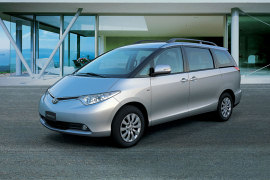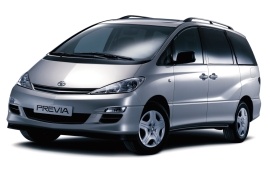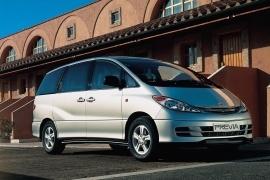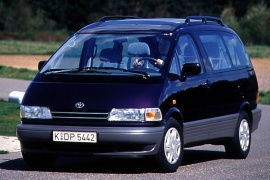TOYOTA Previa / Estima Models/Series Timeline, Specifications & Photos
First production year: 1992
Engines: Hybrid gasoline, Gasoline, Diesel
Body style: Van
The Previa was one of the strangest MPV on the market, with seating for seven, a front-mid engine and rear-wheel-drive. The third generation was launched in 2006 as a 2007 model with a different approach.
While the Europeans looked more for the European brands if they wanted an MPV, in other parts of the world the Previa/Estima had a different impact on the market. For their home-market in Japan, the JDM spec was offered even with a hybrid drive.
The outside look was made to fit into the main Toyota brand image, with a large V-shaped grille and headlights. The overall look was kept from the second Previa generation, but more stylish. Angular shaped and with flat curved surfaces, the car looked more like an Edge-design era, a trend that was already gone in 2007.
Inside, there were more options for the number of seats and the way those were placed. The last seat row could have been folded and stored under the flat floor. Thus, the middle row could have been moved back and created more legroom. The rear sliding doors were electrically powered, as an option, or standard depending on the trim level.
The instrument cluster was particularly interesting, with analog dials but placed further back on the dashboard. The 3D appearance was not a usual design for the dashboards, but it worked well on the Estima.
Toyota unveiled the second's generation Previa facelift in 2000 and, in 2003, the Japanese carmaker tried to do a facelift on it.
Why just "tried" and not "did"? Because you'll need a Toyota specialist to see the differences between the 2000 and the 2003 model-year. It shared the same platform with the Camry, which was highly appreciated for its comfortable ride and reliability. The Previa took all of these and added more space.
Its ovoid-shape design with angular headlights remained similar to non facelifted version. Basically, the windshield and the hood were part of the same line, which was extended over the roof to the vehicle's back. Following the biodesign trend, the Previa featured a curved tailgate instead of a flat one as some other MPVs on the market.
Inside, the car offered room for up to seven adults, and there was even some trunk left after filling all the seats. Toyota offered the Previa with an option for captain seats in the middle row. The design team provided an exciting dashboard, with the dials installed in the middle so everyone could see them. Circular and waved lines were used all over the interior, from the door panels to the ashtray covers. Strangely, only the air-vents were squared, like they were some left-overs from other vehicles.
The first generation was criticized for not having a V6 engine. It was not the same situation with the second generation, which Toyota offered with either an inline-four or a 3.0-liter V6. For selected markets, the Previa was fitted with a turbodiesel engine.
Toyota introduced the second generation of the Previa in 2000, but its main target was no longer the U.S. market, unlike its predecessor.
It was a significant change for the Japanese minivan. While the 1990 model featured a mid-engine and rear-wheel-drive configuration, its successor came with a front-engine front-wheel-drive setup. The MPV was mainly prepared for the European, Asian, and Australian markets. For the U.S. customers, Toyota offered the Sienna, which ended up being a safer car than the first Previa generation, but more prone to break on the roads. At least it provided a V-6.
From the exterior, Previa's second-generation looked stunning for a minivan. It featured a steep front fascia, with an arched line that continued from the bottom of the grille, along with the hood and the gigantic windshield, and up to the roof. From there, the arched line continued a soft descending slope toward the rear roof spoiler. From its sides, the blackened side pillars left the impression of a floating roof. A pair of sliding doors made the ingress and egress easier to the car.
Inside, it offered room for up to eight people, but the best choice was the seven-seat version with middle captain seats that could rotate and slide back and forth. At the front, the car-like dashboard design featured a semi-hidden center-mounted instrument cluster, which could have been seen only by the driver. Toyota installed the audio and climate controls on the center stack's upper side and a storage area at the bottom.
Under the hood, Toyota installed a choice of two engines: a 2.4-liter gasoline and a 2.0-liter turbo-diesel. The latter was the best choice for a long-distance runner since it provided outstanding fuel efficiency.
With a unique engine layout, the Toyota Previa was one of the weirdest minivans on the market.
While mounting the engine in the middle instead of the front of the vehicle put more weight over the rear tires and provided more traction, the Previa was equipped with an underpowered engine, as larger units did not fit.
As the Americans were used to large engines and power, the Previa was not among their favorite minivans. The 2.4-liter engine developed only 135 hp, and for a car that could accommodate up to 8 people, it was simply not enough.
Brought to life to replace the Toyota Van, the Toyota Previa was available with a rear-wheel or an all-wheel-drive system.
The Toyota Previa was available with a 5-speed manual transmission or a 4-speed automatic gearbox.
Depending on the market, the minivan offered seating for 7 or 8 people, with three seating configurations available. In North America, the Previa was not offered the 8-passenger seat configuration.
Having the unusual engine layout, the Previa had a low nose, thus allowing tremendous front visibility for all occupants.
The minivan had either front discs with rear drum brakes or 4-wheel disc brakes.
If Toyota hoped to beat Dodge at their own game, well, they didn’t manage to do it.



